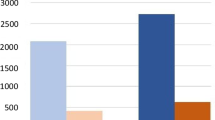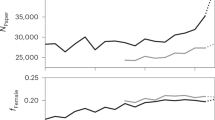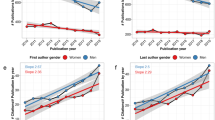Abstract
This paper uses two large databases, one of given names and one of family names, to categorise the names of researchers from Italy, Sweden, the UK and the USA whose papers in astronomy and oncology were published in 2006–2007 and in 2011–2012 by sex (gender) and ethnicity or national origin. For all the countries, there were relatively many more females publishing papers in oncology than in astronomy, but their share of contributions was lower than the percentage of researchers. Sweden and the UK had much higher percentages of both other European and Rest of the World researchers than Italy did. US researchers with non-European names were categorised in six main country groups. The ones with the greatest presence were Chinese (mainly Mandarin) and South Asians (mainly Indians). The method could be adapted to investigate the progress of women in research in many other countries, and the role played by non-national researchers in their scientific output.


Similar content being viewed by others
References
Abramo, G., d’Angelo, C. A., & Caprasecca, A. (2009). Gender differences in research productivity: A bibliometric analysis of the Italian academic system. Scientometrics, 79, 517–539.
Adman, P. (2011). Investigating political equality: The example of gender and political participation in Sweden. Acta Politica, 46(4), 380–399.
Basu, A., & Lewison, G. (2005). Going beyond journal classification for evaluation of research outputs: A case study of global astronomy and astrophysics research. ASLIB Proceedings, 57(3), 232–246.
Basu, A., Roe, P., & Lewison, G. (2012). The Indian diaspora in cancer research: a bibliometric assessment for Canada and the USA. In: Proceedings of the 17th International Conference on Science and Technology Indicators (pp. 110–120). Montréal: Science-Metrix.
Batista, PD., & Leta, J. (2009). Brazilian authors’ scientific performance: Does gender matter? In: Proceedings of the 12th International Conference on Scientometrics and Informetrics (pp 343-353). Rio de Janeiro.
Beji-Becheur, A., Ozcaglar-Toulouse, N., & Zoaghi, S. (2012). Ethnicity introspected: Researchers in search of their identity. Journal of Business Research, 65(4), 504–510.
Blanke, J., & Chiesa, T. (eds). (2013). The Travel and Tourism Competitiveness Report 2013. Geneva: World Economic Forum. Available at: http://www3.weforum.org/docs/WEF_TT_Competitiveness_Report_2013.pdf. ISBN-13: 978-92-95044-40-1.
Boswell, C. (2012). How information scarcity influences the policy agenda: Evidence from UK immigration policy. Governance – An International Journal of Policy Administration and Instituions, 25(3), 367–389.
Brush, S. G. (1991). Women in science and engineering. American Scientist, 79(5), 404–419. Available at: http://www.jstor.org/stable/29774475.
Carnes, M., Schular, L., Sarto, G. E., Lent, S. J., & Bakken, L. (2006). Increasing sex and ethnic/racial diversity of researchers in aging: Some promising strategies at the post-doctoral level. Journal of the American Geriatrics Society, 54(6), 980–985.
Cohen, J. J. (1998). Time to shatter the glass ceiling for minority faculty. Journal of the American Medical Association, 280(9), 821–822.
Dahlstrom, C., & Esaiasson, P. (2013). The immigration issue and anti-immigrant party success in Sweden 1970–2006: A deviant case analysis. Party Politics, 19(2), 343–364.
de Cheveigne, S. (2009). The career paths of women (and men) in French research. Social Studies of Science, 39(1), 113–136.
Einaudi, P. (2011). Two decades of increasing diversity more than doubled the number of minority graduate students in science and engineering. Washington DC: NSF. National Center for Science and Engineering Statistics, paper NSF 11-319.
Ellemers, N., van den Heuvel, H., de Gilder, D., Maass, A., & Bonvini, A. (2004). The under-representation of women in science: Differential commitment or the queen bee syndrome? British Journal of Social Psychology, 43(3), 315–338.
Govoni, P. (2013). The power of weak competitors: Women scholars, “popular science”, and the building of a scientific community in Italy, 1860s–1930s. Science in Context, 26(3), 405–436.
Green-Pedersen, C., & Krogstrup, J. (2008). Immigration as a political issue in Denmark and Sweden. European Journal of Political Research, 47(5), 610–634.
Gryn, T., & Gambino, C. (2012). The foreign born from Asia: 2011 Washington DC: US Department of Commerce, United States Census Bureau. Available at: http://www.census.gov/prod/2012pubs/acsbr11-06.pdf.
Gupta, N., Kemelgor, C., Fuchs, S., & Etzkowitz, H. (2005). Triple burden on women in science: A cross-cultural analysis. Current Science, 89(8), 1382–1386.
Hanks, P. (Ed.). (2003). Dictionary of American family names, (pp. xxv–xxvi). Oxford: OUP.
Ivie, R., & Tesfaye, C. L. (2012). Women in physics: A tale of limits. Physics Today, 65(2), 47–50. Available at: http://dx.doi.org/10.1063/PT.3.1439.
Ivie, R., White, S., Garrett, A., & Anderson, G. (2013). Women among physics and astronomy faculty: Results from the 2010 survey of physics degree-granting departments. College Park, MD: American Institute of Physics, Statistical Research Center.
Kurup, A., & Maithreyi, R. (2011). Beyond family and societal attitudes to retain women in science. Current Science, 100(1), 43–48.
Lewison, G. (2001). The quantity and quality of female researchers: a bibliometric study of Iceland. Scientometrics, 52(1), 29–43.
Lewison, G. (2011). Definition of cancer research: Journals, titles, abstracts or keywords? DESIDOC Journal of Library and Information Technology, 31, 333–339.
Lewison, G., & Jacobs, D. (2011). Science in South Africa: have Black Africans, Coloureds and Indians prospered since the ending of apartheid? In: Proceedings of the 13th Conference of the International Society of Scientometrics and Informetrics (pp. 418–429). Durban.
Lewison, G., & Leta, J. (2003). The contribution of women in Brazilian science: a case study in astronomy, immunology and oceanography. Scientometrics, 57, 339–353.
Lewison, G., & Markusova, V. (2011). Female researchers in Russia: Have they become more visible? Scientometrics, 89, 139–152.
Longley, P. A., Webber, R., & Lloyd, D. (2007). The quantitative analysis of family names: Historic migration and the present day neighbourhood structure of Middlesbrough, United Kingdom. Annals of the Association of American Geographers, 97(1), 31–48.
Mauleon, E., Bordons, M., & Oppenheim, C. (2008). The effect of gender on research staff success in life sciences in the Spanish national research council. Research Evaluation, 17, 213–225.
Mulvey, G. (2010). When policy creates politics: The problematizing of immigration and the consequences for refugee integration in the UK. Journal of Refugee Studies, 23(4), 437–462.
NSF. (2013). Women, minorities, and persons with disabilities in science and engineering: 2013. Washington DC: National Science Foundation, Aug 2013. Available at: http://www.nsf.gov/statistics/wmpd/2013/pdf/nsf13304_full.pdf.
Orrenius, P. M., & Zavodny, M. (2012). The economics of US immigration policy. Journal of Policy Analysis and Management, 31(4), 948–956.
Palepu, A., Carr, P. L., Friedman, R. H., Amos, H., Ash, A. S., & Moskowitz, M. A. (1998). Minority faculty and academic rank in medicine. Journal of the American Medical Association, 280(9), 767–771.
Webber, R. (2010). Researching behavioural differences among ethnic minority groups: The case for inferring ethnicity on the basis of people’s names. International Journal of Market Research, 52(2), 191–215.
Webster, B. M. (2001). Polish women in science: A bibliometric analysis of Polish science and its publications, 1980–1999. Research Evaluation, 10, 185–194.
Webster, B. M. (2004). Bibliometric analysis of presence and impact of ethnic minority researchers on science in the UK. Research Evaluation, 13(1), 69–76.
Widnall, S. E. (1988). AAAS presidential lecture: Voices from the pipeline. Science, 241, 1740–1745.
Zincone, G. (2006). The making of policies: Immigration and immigrants in Italy. Journal of Ethnic and Migration Studies, 32(3), 347–375.
Author information
Authors and Affiliations
Corresponding author
Rights and permissions
About this article
Cite this article
Roe, P., Lewison, G. & Webber, R. The sex and ethnicity or national origins of researchers in astronomy and oncology in four countries, 2006–2007 and 2011–2012. Scientometrics 100, 287–296 (2014). https://doi.org/10.1007/s11192-013-1223-1
Received:
Published:
Issue Date:
DOI: https://doi.org/10.1007/s11192-013-1223-1




